Circuitsmith's Hybrid-Electric Bicycle Blog

Electric Power Assist Bicycle
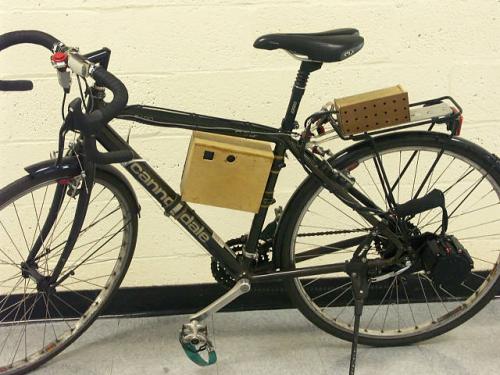
7/2/2002:
I first took interest in power assisted bikes when I saw a rider go by on a bike equipped with a tiny gasoline motor. It buzzed like a weed whacker and left a faint trail of blue smoke. But the older gentleman was flying along up a mild incline, peddling with easy effort. I did some searching on the internet and found out that there are several current and defunct companies that sold bicycle motors, gas and electric. Here are some links to discussion groups for electric and power assist vehicles:
Power assist increases the utility of a bicycle greatly. Travel faster, farther and carry more. Since I can vary the amount of assistance the bike can still be good exercise. I can ride in downtown DC in 95°+ F weather to run errands etc. in regular work clothes without breaking a sweat. Parking is not an issue, and I can obey traffic signals without regretting the lost momentum due to starting and stopping. The range of my bike is ~10 miles with moderate pedaling. Costs less than a nickel of electricity per charge.
I went with electric because it’s quieter, not smelly and I can carry it up a flight of stairs. I chose the conversion kit made by Currie. Factory service is nonexistent, but EVdeals is a good, knowledgeable dealer. The motor delivers more than ½ horsepower (600W), which is plenty for a bike. Assistance is limited to about 20mph, but there is lots of midrange torque. The rear wheel is driven through an adapter which mates with the rear hub.
I had to modify the system from the start because it was not designed to work with the fat frame tubes of my aluminum Cannondale touring bike. The kit is really geared toward steel frame mountain and hybrid bikes. I had to grind notches into the drive plate that holds the motor, gears and chain. I had to modify the battery mount. I added a voltmeter that indicates half the actual voltage (to gain a significant digit). I had to mount the throttle upside-down on the drop handle bars. Finally, I made a heat sink out of a 5x7" sheet of 1/16" aluminum. The stock setup is considered prone to overheating.
I loosely bolted the propulsion unit to the rear wheel of my Cannondale T-400 touring bike and tried to install it on the frame. All the frame tubes are larger, being aluminum. So the propulsion unit went against the chain stays. I ground a couple of notches into the propulsion unit to make clearance. It still touches the chain stays and I hope it won't be a problem. The hose clamp for the torque arm barely made it around the fat chain stay.
I mounted the throttle upside down on the top of my drop handlebars. I used some black duct tape to cover the openings. I work the throttle by pulling it up with my index and middle finger. It's quite comfortable.
The battery mounting scheme wouldn't fit in the frame triangle, again because of the fat frame tubes. So I opened up the battery box and removed the tab for fastening with the key and strapped the front of the battery box to the top tube with a long hose clamp. The seat tube bracket works OK.
During all of this I charged the batteries with the supplied charger. They sent me two chargers, by mistake I assume. These chargers are labeled 2 amps and seem to be pretty smart. When the battery reached 30V it switched to float mode at 27.3V. The charger is 3x6x12 cm and light. It's a switching supply and caused some TV interference next to a TV with rabbit ears. The first charge took 3 hours.
Yesterday evening I excitedly took the bike out for a spin around my neighborhood. The acceleration was a little startling at first and it was quieter than I thought it would be, a whirring that gets quieter up to speed. The weight distribution is good, it doesn't seem to adversely affect the handling. I weigh 145lbs BTW. I haven't weight the bike with the kit on but it's tolerable carrying it up one flight of stairs. I increased the air in my (32mm) Conti. Top Touring tires 5 lb to 65psi front, 75psi rear.
This morning I rode to work, about 1.5 miles. I don't NEED the assist for this commute but it sure is fun. I work in a college electrical engineering dept. so I spent most of the morning letting co-workers take rides. It was quite a sensation. The battery recharged in 2 hours.
I cut a 5x8" piece of 1/16" aluminum sheet and cut the holes for it to fit between the motor and propulsion unit, ala Jay Ward, and mounted it with thermal grease.
Then I went downtown (Wash. DC) to run some errands and show the kit to the folks at the bike shop I frequent. The whole trip was about 5 miles. There were some moderate hills, gridlock traffic, and 95 degree sunny weather. The system worked flawlessly. No manic couriers whizzing by me up hills. I didn't break a sweat until I got off the bike, no more breeze.
Today I fully opened the battery box. Boy, did they pack it in! I tightened the connectors and also soldered the crimps on the battery and switch connectors. Of course I disconnected each lug from the battery before I soldered. The indicator light is an LED and draws only 10mA so it get a reprieve. I recall reading somewhere it drew more current.
I couldn't find a place to flush mount my little LCD voltage display so I strapped it outside on the carrying handle.
I added another wire to the 3 pin charging connector, leading to the middle battery connector. Now I can measure or charge the two batteries individually. This [XLR] connector is originally for microphones, readily available.
I also finished building a charger that will charge the batteries individually. I'll use that periodically to make sure both batteries get fully charged. The batteries are Portalac Model PE12V12 made by Japan Storage Co. They measure 3 7/8 X 3 11/16 X 5 15/16.
I did a little more grinding on the propulsion unit and added a washer between the frame and rear axle so there is definite clearance between the propulsion unit and frame tubes.
The foam rubber where the torque arm clamps to the chain stay wore away so I put a piece of much tougher neoprene there.
The chain tensioner got noisy so I replaced it with one of Scott McGregor's replacement blocks. Much better. Great job Scott! That chain seems to stretch a lot. I've had to adjust every 20 miles or so. I tried to remove a pair of links - no way. I'll eventually have to get a half link from Scott.
I designed a charger that charges the two 12V lead-acid batteries individually rather than in series like the stock charger, for better balance.
- circuitsmith's blog
- Log in or register to post comments
Who's online
There are currently 0 users online.
Who's new
- eric01
- Norberto
- sarim
- Edd
- OlaOst

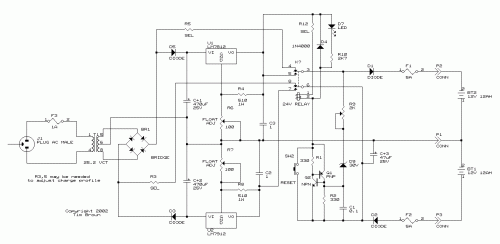


Comments
Re: Circuitsmith's Hybrid-Electric Bicycle
10/8/2002:
The stock throttle starts the motor with a jerk unless it's used gingerly. Also, the throttle acts like a cruise control (full power up to a set speed). I designed a simple circuit that uses a push button to ramp up power to the motor for smoother starts.
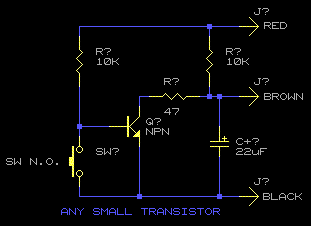


More details.
There are 3 wires that go to the throttle, let's call them SOURCE, SENSE, and GROUND. With ground as reference: sense is at a constant +5V, SENSE controlls motor speed. Impedance from SENSE to GROUND is about 600Kohm, SENSE positive, power on. When SENSE rises above 110mV the motor control circuit energizes. Below 180mV the motor doesn't turn but it becomes much more difficult to turn it backwards or forwards. Above 180mV the motor starts turning. No matter how slowly SENSE is raised the motor starts abruptly with a slight jerk. Motor speed rises in proportion to the voltage on SENSE until it reaches 3.6V at which point the motor abruply jumps from medium to full speed.
Schematic.
Throttle
Heat sink
Re: Circuitsmith's Hybrid-Electric Bicycle
11/26/2002:
I purchased some NiMH batteries from BatterySpace. These are 6V 4AH packs (5 "C" cells). I made two 24V 4AH strings. The strings are connected in parallel to operate the bike and charged separately.
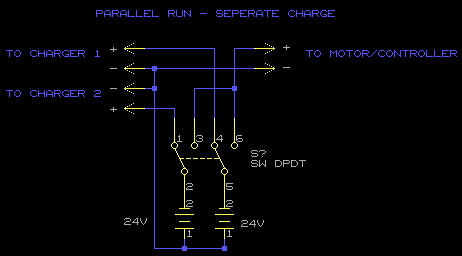
Pack schematic. ( fuses not shown.)
I built a light, strong box to hold them out of plywood. This battery weighs 8lbs versus 20lbs for the stock lead acid battery.
More details.
Each pack is 5 C cells. The attached leads are too thin [22 gauge] for this application, but there are ribbons spot welded to the cells and two ribbons that seem to have been test tabs. I used these ribbons and 14 gauge wire to interconnect the battery packs. I wired up two 24V 4AH strings. Each goes through a 20A fuse and to a SPDT switch. When switched on the strings are in parallel and when off they are seperate. I used an female XLR connector for charging, like the stock Currie box. I made a light, compact box out of 1/4" plywood with lots of metal 'L' brackets for bracing. The bottom is perforated board for a little ventilation.
After assembly I charged the batteries with a dual bench power supply. I charged them at 2A keeping a close watch [battery box open] until they started to feel warm. That took about an hour, so they came with a substantial charge. Then I charged them about 12 hours [overnight] at 200mA. They were then lukewarm and floating at about 28.5V.
I then mounted the box on the bike and took a test ride. First, going down [and later up] the stairs on the front of my house was less of a chore. My bat box is narrower than the Currie so it doesn't brush against my legs. Steering is more nimble.
On the down side there is slightly less low speed torque and I will have to work harder up steep hills. I rode about 6 miles without charging the pack and the power output was consistent. I wanted to run the batteries down to the low voltage cutoff [to break them in] but I decided to test the charger I built. The resting voltage was down to 24.8V but the motor seemed to pull as strongly as when freshly charged.
The charger I built is a simple affair. It delivers approx 2A to each string until a threshold voltage is reached, then it trickles at 100mA [C/40]. The trick is to set the threshold voltage low enough that the charge voltage never approaches the peak and fallback characteristic if nickel based batteries as the battery nears full charge, and that if a fully charged battery is connected it trips the threshold. With close observation I'll find a conservative threshold. Keeping ambient temp in a fairly narrow range helps to. Looks like 28.25V is about right. I know there are sophisticated battery management chips etc., but I built this baby from parts already on my shelf in a short time. It's trickling as I write. I chose a low trickle of 100mA to limit heating because of the tight packaging.
While others have switched to even bigger, heavier batteries like the 16AH Hawker, I prefer a lighter battery for the short-range (<10mi) riding I mostly do. The whole bike weighs about 43lb.
Re: Circuitsmith's Hybrid-Electric Bicycle
Update 10/04: Photos below show the inside of the old vs new NiMH packs
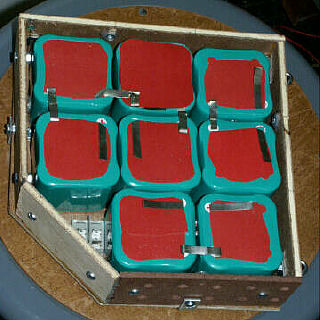
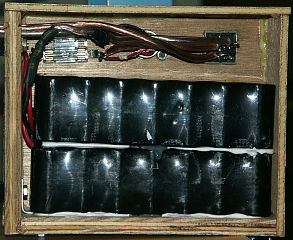
Re: Circuitsmith's Hybrid-Electric Bicycle
2/24/2003:
I have set up my Currie to run on 30V with an unmodified silver can motor. I designed a circuit to switch a seperate 6V battery in series with the main 24V batt. When the throttle is switched on the main batt voltage drops under load. When it rises [as motor speed increases] above 19V the additional 6V is switched in and latched on until the throttle is released. There are several advantages to this scheme. First, low speed motor current is not increased. Second, the effect of my smooth start throttle circuit is retained. Third, the motor's low voltage cutoff will still protect the battery.
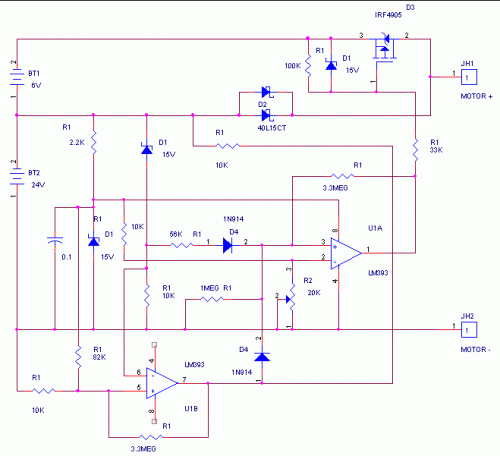
Schematic Midrange power is noticeably increased, as is top speed. The batteries are in a small box under the seat.
(Larger view at http://mysite.verizon.net/tbrown59/gif/24boost.gif)
Re: Circuitsmith's Hybrid-Electric Bicycle
Wow, Seo detailed! Thanks for sharing this with us.
Re: Circuitsmith's Hybrid-Electric Bicycle Blog
Nice job. Thought I'd share a build I completed 2010. This modified Bionx system is capable of 190 miles at moderate assist
and complete weighs 60lbs, although I currently run a single battery (front) setup which drops the weight to about 40lbs.
Happy riding...
Jim
Re: Circuitsmith's Hybrid-Electric Bicycle Blog
Hello!-I just read your notes on your bike, I am also in the DC area, located just north of DC in Adelphi, Md.-near Md.University. I am an electronics nut, ham radio operator, Wavecrest hybrid bike rider, and owner of a VECTRIX electric police scooter, plus a six cylinder Honda Goldwing motorcycle. Perhaps we could chat/meet sometime? My phone is:301-439-3873--Bob Curry, KC3VO (Ham radio callsign)
Robert M. Curry
Re: Circuitsmith's Hybrid-Electric Bicycle Blog
Would love to chat, but meeting will be tough cause I live in south S.F. bay area, Los Gatos, Ca.
My phone is 408-355-4748. Weekends are best. Take care...
Jim~
Jim